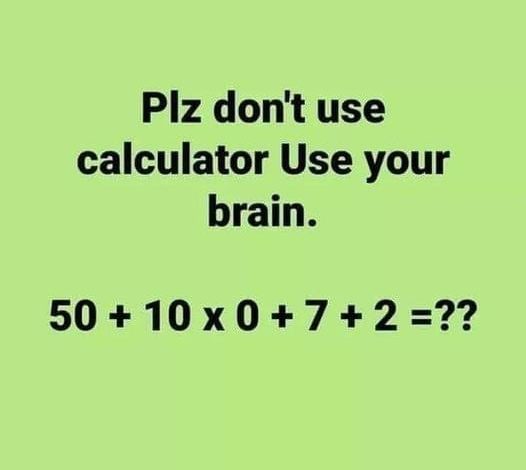
ADVERTISEMENT
The Order of Operations: Decoding the Simple but Tricky Math Problem
Mathematical challenges, especially those presented in the form of puzzles, often seem straightforward but can easily trip us up if we’re not careful. The problem shown in the image—50 + 10 x 0 + 7 + 2 = ??—is a perfect example of how the correct application of basic arithmetic rules is crucial for arriving at the right answer. This puzzle tests not only your math skills but also your ability to follow the order of operations, a fundamental principle in mathematics.
Understanding the Order of Operations
The key to solving this problem lies in the proper application of the order of operations, commonly remembered by the acronym PEMDAS:
- Parentheses first
- Exponents (i.e., powers and square roots, etc.)
- Multiplication and Division (from left to right)
- Addition and Subtraction (from left to right)
In the absence of parentheses and exponents in this equation, the focus is on handling the multiplication, followed by addition, in the correct sequence.
Breaking Down the Equation
Let’s break down the problem step by step:
- The Original Problem:
50+10×0+7+250 + 10 \times 0 + 7 + 250+10×0+7+2
- Step 1: Address the Multiplication First: According to PEMDAS, multiplication comes before addition. So, we first compute:
10×0=010 \times 0 = 010×0=0
- Step 2: Substitute the Result Back into the Equation: Now, replace the multiplication with its result:
50+0+7+250 + 0 + 7 + 250+0+7+2
- Step 3: Perform the Addition from Left to Right: Next, simply add the numbers from left to right:
50+0=5050 + 0 = 5050+0=50 50+7=5750 + 7 = 5750+7=57 57+2=5957 + 2 = 5957+2=59
- Final Answer: The correct answer to the equation is 59.
Common Mistakes and Misconceptions
This problem is a classic example of how easy it is to overlook the importance of the order of operations. Many people might instinctively add the numbers as they appear or neglect to perform the multiplication first, leading to incorrect answers. A common incorrect result might be obtained if someone simply adds the numbers in sequence without giving priority to multiplication, potentially arriving at the wrong conclusion.
ADVERTISEMENT
The Value of Mental Math Challenges
Mental math problems like this one are valuable for several reasons. They help sharpen our cognitive abilities by forcing us to remember and apply fundamental rules. They also encourage us to be careful and methodical in our approach, which is a useful skill in many aspects of life, not just mathematics.
Such exercises are also great for keeping the brain active and engaged. They challenge us to think critically and pay attention to detail, qualities that are beneficial far beyond the realm of arithmetic.
Conclusion: The Importance of the Basics
The equation presented in the image is a reminder of the importance of the basics in mathematics. No matter how advanced math becomes, understanding and correctly applying the order of operations is crucial for solving problems accurately.
The answer to the problem is 59, but the real takeaway is the reinforcement of careful and methodical thinking. Whether you’re a student, a professional, or someone just looking to keep your mind sharp, challenges like these are a fun and effective way to stay on top of your game.
Next time you encounter a similar problem, remember to apply PEMDAS, and you’ll be well on your way to solving it correctly—no calculator needed!
ADVERTISEMENT
This article explores the importance of the order of operations in solving a seemingly simple math problem. If there are any specific aspects you’d like to delve deeper into or if you have other questions, feel free to ask!




